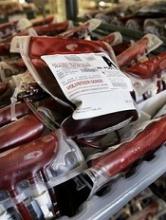User login
Blood banks in countries that accept the CE mark can now use the Procleix Zika Virus Assay to screen blood donations for the presence of Zika virus.
CE marking means a product conforms to relevant legislation for sale in the European economic area.
The Procleix Zika Virus Assay, which was developed by Hologic, Inc. and Grifols, is designed to run on the Procleix Panther System, an automated, nucleic acid technology (NAT) blood screening platform.
NAT enables detection of infectious agents in blood and plasma donations.
The Procleix Panther system automates all aspects of NAT-based blood screening on a single, integrated platform.
The system has received regulatory approvals in countries around the world, and it is in development for the US market.
In the US, the Procleix Zika Virus Assay is being used under an investigational new drug protocol in response to the US Food and Drug Administration’s recommendation to screen all US blood donations for Zika virus.
“The CE marking of the Procleix Zika virus assay is a further step in our mission to support safer blood donations, the result of our passion for innovation and the role we play as market leaders in transfusion medicine,” said Grifols Diagnostic Division President Carsten Schroeder.
About Zika virus
Zika is a mosquito-borne virus that was first identified in rhesus monkeys in Uganda in 1947 and in humans in 1952. Outbreaks of Zika virus have been recorded in Africa, the Americas, Asia, and the Pacific.
Zika virus is transmitted to humans primarily through the bite of an infected mosquito from the Aedes genus, mainly Aedes aegypti, in tropical regions.
Sexual transmission of Zika virus is also possible, and reports have suggested Zika can be transmitted via transfusion of blood products. Other modes of transmission are being investigated as well.
In total, 64 countries and territories have reported transmission of Zika virus since January 1, 2007. ![]()
Blood banks in countries that accept the CE mark can now use the Procleix Zika Virus Assay to screen blood donations for the presence of Zika virus.
CE marking means a product conforms to relevant legislation for sale in the European economic area.
The Procleix Zika Virus Assay, which was developed by Hologic, Inc. and Grifols, is designed to run on the Procleix Panther System, an automated, nucleic acid technology (NAT) blood screening platform.
NAT enables detection of infectious agents in blood and plasma donations.
The Procleix Panther system automates all aspects of NAT-based blood screening on a single, integrated platform.
The system has received regulatory approvals in countries around the world, and it is in development for the US market.
In the US, the Procleix Zika Virus Assay is being used under an investigational new drug protocol in response to the US Food and Drug Administration’s recommendation to screen all US blood donations for Zika virus.
“The CE marking of the Procleix Zika virus assay is a further step in our mission to support safer blood donations, the result of our passion for innovation and the role we play as market leaders in transfusion medicine,” said Grifols Diagnostic Division President Carsten Schroeder.
About Zika virus
Zika is a mosquito-borne virus that was first identified in rhesus monkeys in Uganda in 1947 and in humans in 1952. Outbreaks of Zika virus have been recorded in Africa, the Americas, Asia, and the Pacific.
Zika virus is transmitted to humans primarily through the bite of an infected mosquito from the Aedes genus, mainly Aedes aegypti, in tropical regions.
Sexual transmission of Zika virus is also possible, and reports have suggested Zika can be transmitted via transfusion of blood products. Other modes of transmission are being investigated as well.
In total, 64 countries and territories have reported transmission of Zika virus since January 1, 2007. ![]()
Blood banks in countries that accept the CE mark can now use the Procleix Zika Virus Assay to screen blood donations for the presence of Zika virus.
CE marking means a product conforms to relevant legislation for sale in the European economic area.
The Procleix Zika Virus Assay, which was developed by Hologic, Inc. and Grifols, is designed to run on the Procleix Panther System, an automated, nucleic acid technology (NAT) blood screening platform.
NAT enables detection of infectious agents in blood and plasma donations.
The Procleix Panther system automates all aspects of NAT-based blood screening on a single, integrated platform.
The system has received regulatory approvals in countries around the world, and it is in development for the US market.
In the US, the Procleix Zika Virus Assay is being used under an investigational new drug protocol in response to the US Food and Drug Administration’s recommendation to screen all US blood donations for Zika virus.
“The CE marking of the Procleix Zika virus assay is a further step in our mission to support safer blood donations, the result of our passion for innovation and the role we play as market leaders in transfusion medicine,” said Grifols Diagnostic Division President Carsten Schroeder.
About Zika virus
Zika is a mosquito-borne virus that was first identified in rhesus monkeys in Uganda in 1947 and in humans in 1952. Outbreaks of Zika virus have been recorded in Africa, the Americas, Asia, and the Pacific.
Zika virus is transmitted to humans primarily through the bite of an infected mosquito from the Aedes genus, mainly Aedes aegypti, in tropical regions.
Sexual transmission of Zika virus is also possible, and reports have suggested Zika can be transmitted via transfusion of blood products. Other modes of transmission are being investigated as well.
In total, 64 countries and territories have reported transmission of Zika virus since January 1, 2007. ![]()

